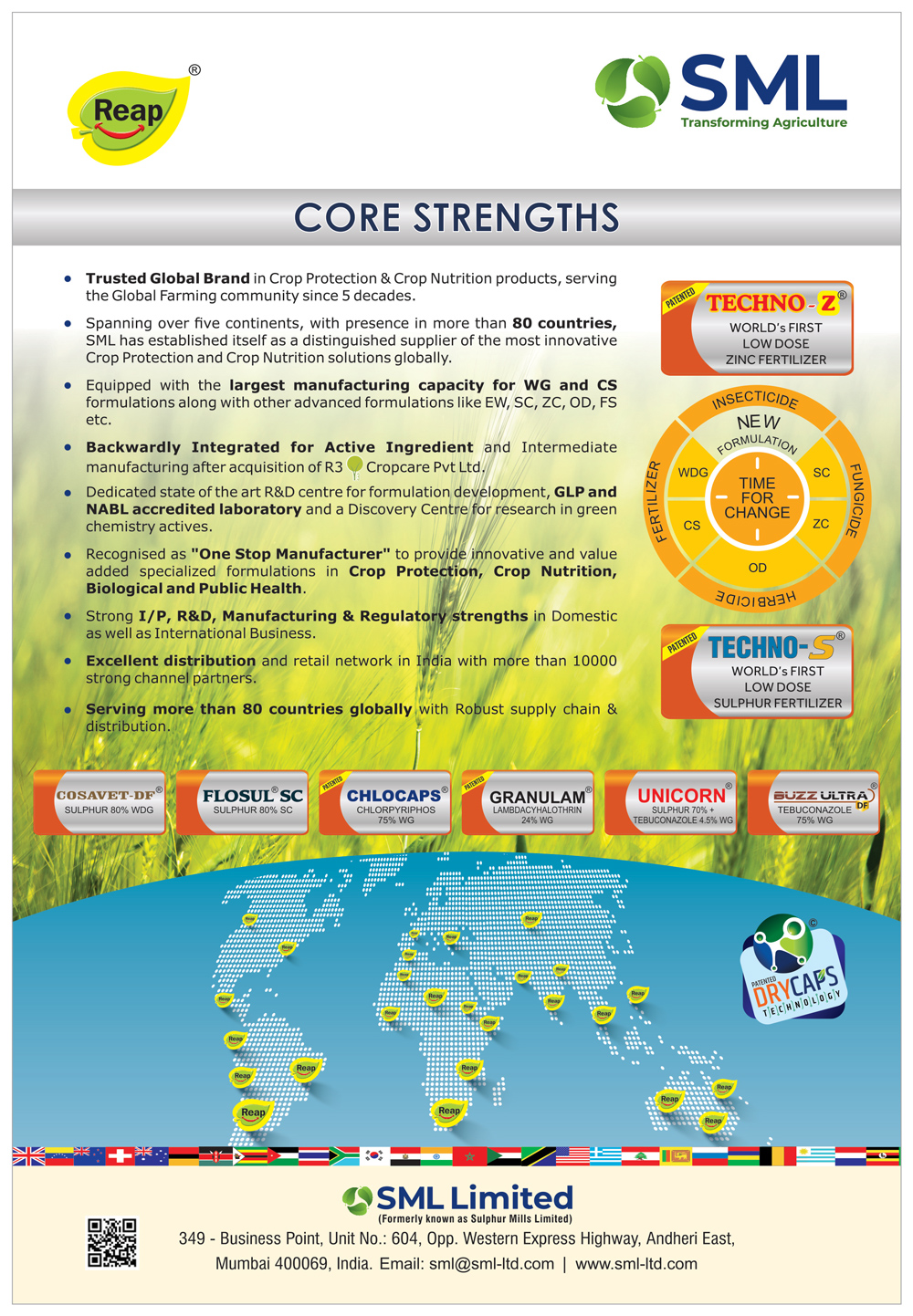Bringing Biologicals to Southeast Asia
Scroll Down to Read
Governments of Southeast Asian countries want their growers to use sustainable agriculture, in which biologicals play an essential role and synthetic chemicals get phased out. The reality of launching a new biological product in this region is faced with a variety of different registration standards and processes that can break the bank for start-ups or smaller companies.

Jérémy Dauchin, Head of APAC at Rovensa Next
“Each country requires a tailored approach due to various influencing factors such as political decisions shaping the regulatory environment, farmers’ experience and education on biologicals, market accessibility, and the value solutions,” says Jérémy Dauchin, Head of APAC at Rovensa Next. “The maturity in adopting biologicals varies greatly, with their use primarily limited to cash crops while conventional solutions remain prevalent. Despite the high market potential, the penetration speed of biologicals is relatively slow.”
While the return on investment might be slow, governments are positioning the market for biologicals. Here are some insights on how to get your biological product launched successfully in Southeast Asia.
Understanding the Market
Before launching your product, it’s important to know the market landscape and the pitfalls to avoid.
- Small Market: Generally, in Southeast Asia, crop protection usage is lower than Europe and North and South American countries, especially in fungicides, says Lawrence Middler, Senior Analyst for AgbioInvestor. “Of course there will be exceptions to this where certain growers – particularly for fruit and vegetable and specialities – will employ products with a more niche focus, but these will likely be in response to specific pest and plant health challenges.”

Fernando Lopez, Asia Pacific Lead, Agro Division for Lamberti
- Crop Focus: With the majority of farmers focusing on palm oil and rice, the need for biologicals isn’t essential for these growers. Fernando Lopez, Asia Pacific Lead, Agro Division for Lamberti. “[Growers] don’t care about biologicals, unless they have a unique value proposition,” says Lopez. “There are few of those value propositions for palm oil and rice crops. For example, if the brown plant hopper in rice becomes resistant to most conventional chemical insecticides, then farmers would try a well-positioned bioinsecticide.”
- Consumer Demand: A growing middle class in many parts of Southeast Asia will purchase and desire quality fruits and vegetables with lower MRLs. This will open up new market opportunities to growers. “When pest control efficacy and output quality improvement are ensured [in biological products], the value of investing in these solutions is evident, as the return for the farmer is demonstrated,” says Dauchin. “Additionally, adopting these practices can provide farmers with more valuable access to specialized and high-quality distribution channels.”
- Government Drivers: Middler says, “Government sustainability targets such as the Zero-Growth policy in China, which aims for constant or lower volumes of conventional crop protection products, as well as food security initiatives, clean water acts, fertilizer reduction targets, and increased operator safety–the opportunity is there in Southeast Asia for those companies that have a clear go-to-market strategy in place.”
Thailand, Vietnam, Indonesia, Philippines, and Malaysia are working to increase biologicals. “Much of the opportunity in those countries will come from the stimulating effect of government policies and subsidies that will kick-start further adoption,” says Middler.
While these governments are voicing concerns about synthetic crop protection products and seeking to replace them with biologicals, the efforts are addressing more public concerns versus helping growers to get on board.
“Today, minimal efforts in money or time are provided by SE Asian governments to attract farmers and suppliers to the biological market,” says Dauchin. “One of the first actions for governments should be to create a regulatory environment that recognizes new solutions available in the marketplace. For instance, although the governments of Malaysia, Indonesia, the Philippines, and Thailand encourage farmers to use biocontrol products, there is no specific support to the companies in the registration of these products. To date, only Vietnam has created a specific biopesticide category.”
- MRL Standards: A pain point for many developing countries are the MRL standards imposed by developed countries, like the EU. While this is causing problems, it could also “act as a catalyst for further market adoption,” says Middler.
- Product Resistance: As more synthetic crop protection products are showing resistance in the field, growers are looking for alternatives. “Niche markets serve as the entry point for biological solutions, demonstrating their effectiveness in addressing current farmer challenges such as reduced efficacy due to multiple resistances,” says Dauchin. “The market is changing, and for now, formulators should continue developing products that address real market and farmer issues and needs. As the local business environment remains uncertain, formulators need to stay flexible and adapt their offerings to fit the specific crops and climate of the Southeast Asia area. Strong technical abilities will be crucial in understanding and appropriately responding to field needs.”
A Successful Launch
When launching biologicals among growers, besides a strong registration strategy, companies should plan on:
1. Proven efficacy
Southeast Asia growers still need to be convinced about the value of biologicals. There is no better marketing than word of mouth. “As with any other crop protection product, the marketing effort will benefit from robust efficacy to foster positive grower sentiment,” says Middler.
2. Correct price point
“These farmers live in a dire predicament where staying in business is their definition of sustainability,” says Lopez. “The specific biological need to hold its own in terms of efficacy and cost/hectare.”
3. Education from trusted sources
“The need for effective, efficient, and profitable solutions will always take precedence over environmental advantages,” says Dauchin. “Training and information transfer will be the key to expanding any solutions to promote sustainable agriculture, relying heavily on local experts and trusted networks that will play a crucial role in this transition.”
While this might all seem like something your company cannot provide, Lopez and Middler agree on a strategy: Find a multinational partner in each country, like Bayer or Syngenta, who have successfully distributed biologicals, giving you access to the channel.
“They have access to distributors, can create local marketing materials, and have many people in the field,” says Lopez.
Partnering with a multinational might mean less profitability, but Middler says, “The upside to this is that this approach can lower risk, whilst also creating a greater volume opportunity.”
Formulations That Win
Partnerships not only benefit getting product to market, but also formulating.

Lawrence Middler, Senior Analyst for AgbioInvestor
“In-house formulation operations clearly have the benefit of access to the full breadth and depth of data necessary to maximize product performance,” says Middler. “Independent formulators seeking to gain a competitive advantage should search for partnerships with companies that have the greatest understanding of the active ingredients that they are manufacturing or sourcing.”
Another consideration Middler says is that formulators must think about developing stable formulations and product consistency.
“Product consistency is also a significant consideration, not just for formulators, but the whole value chain,” says Middler. “Regulators are now placing a greater level of scrutiny on the levels of specific biochemical components in products, and if these are not within an acceptable range one year to the next, this could impact the salability and efficacy of product.”
Xuemin Wu, Professor of National Pesticide Formulation & Adjuvant Laboratory at the China Agriculture University in China, says that in formulation, biologicals are facing the following challenges in R&D, go also into application. “The application efficacy of biologicals varies depending on the environment,” says Wu. “Biological formulations, especially microbial formulations, have poor interfacial properties and are difficult to wet and spread, which requires the development of formulations that match specific crops and environments based on the characteristics of the biological formulations, and extensive field trials to verify their effectiveness.”
There is also the issue of combining active ingredients and the effects once in the environment.
“For example, locust microsporidia, this active ingredient is not sensitive to water, can be filtered and directly processed into suspension,” says Wu. “However, the locust microsporidia is sensitive to ultraviolet rays and needs to be added to the anti-ultraviolet adjuvant. Bacillus thuringiensis is easy to damage the spores during the crushing process. So the particle size should be controlled during the crushing process. Beauveria bassiana is sensitive to moisture. And high moisture content will lead to spore germination. So we need to control the moisture content in the preparation.”
Ag Tech in Asia
Partnering with an ag tech company can benefit biological companies from the standpoint of accelerating product design through artificial intelligence.
“Ag tech companies are actively engaged at various levels of the market, aiming to create opportunities and boost the adoption of biologicals by integrating different emerging technologies, which are expected to become the standard in the coming years,” says Dauchin. “This includes focusing on product application, where many ag tech companies are developing diagnostic apps and providing advice on optimal conditions to improve efficacy.”
While there are a variety of start-ups in both biological and ag tech companies, the issue comes in obtaining the funding to keep the businesses going until reaching profitability.
“Integration into precision ag will increasingly become an important outlet for biopesticides and biostimulants in the future, therefore there are clear opportunities for collaboration between ag tech and the industry to bring the most innovative products to market,” says Middler. “The greater opportunity, however, will likely come from the larger multinationals and pure-play biologicals companies that have their own IP, trade secrets and in-house R&D. In these cases, the formulation development will most likely be conducted in-house, and the ag tech partners will facilitate field data provision and delivery technology platforms. In my opinion, this means that the opportunity for collaboration between independent formulators and ag tech companies will not be as significant. Nevertheless, ag tech companies that specialize in nimble formulation development using computational techniques may of course allow for more efficient routes to market for independent formulators seeking to optimize biological AIs.”
Future Opportunity
As Southeast Asia’s population continues to rise, growers will need to replenish soil and increase yields.
As this region’s government aims to decrease synthetic fertilizer, there will be a growing opportunity for biostimulants.
“Although nitrogen fixing biostimulants can be used to reduce field application rates of synthetic nitrogen, overall volumes of chemical fertilizer usage will likely still have to increase,” says Middler. “Poor soils may require some form of NPK or micronutrient application, and biostimulants in isolation will not offer the complete solution, but will of course be an important part of reducing chemical fertilizer usage. Also, biostimulants will increasingly play an important role in mitigating abiotic stress in light of climate change in all but the most extreme weather events.”
